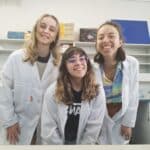
Tagging sharks with Nico Booyens from the Shark Research Unit in Mossel Bay. Photo by Alexa Tedeschi.
Two years ago, we were three students who had been inspired to contribute to the conservation of elasmobranchs (sharks and rays) through our research but felt as though our voices were confined to the bounds of the laboratory. We were working as conservation geneticists, using molecular tools to develop conservation management strategies for endemic and threatened shark and ray species. Outside the lab, we realised just how vulnerable these animals are. The more we spoke to people around us, the more we recognised that many knew nothing about these creatures. The focus was centred around the danger of large predatory species, such as the White shark. Elasmobranchs are one of the most diverse groups of vertebrates on the planet, with more than 1000 different species inhabiting the oceans. They have been able to diversify so extensively because they have been around for almost half a billion years! As bizarre as it sounds, sharks are older than trees (and dinosaurs). However, the first shark didn’t quite resemble the ones we know today. Chondrichthyans (sharks, rays, skates, and chimaeras with a cartilaginous skeleton) branched off from bony fish approximately ~400 million years ago. We know this because there is fossil evidence like teeth from Delodio problematicus (a “prototype shark”) and traces of skin, muscles, and organs from Cladoselache (more “shark-like”). Elasmobranchs weathered five mass extinction events. With little competition for resources due to other species being wiped out, they truly embraced their uniqueness.
This uniqueness is evident through their extraordinary assortment of physiological features and behaviours. From the Epaulette “walking” sharks which use their fins to navigate over reefs and rocky ocean beds, to Hammerhead sharks with their binocular vision and deep-sea Lantern sharks which use bioluminescence to glow in the dark, the list of evolutionary wonders is endless. The most exciting part for us as scientists is that there is so much still to discover about these fascinating ocean-dwellers. Unfortunately, it can be difficult to study these animals in their natural habitat which is why we still don’t know an awful lot about behaviours such as mating and dispersal. Thankfully, genetic data has been useful in revealing some of their secrets. For example, we can use genetic markers to determine whether a single female shark is pregnant with a litter of pups that have different fathers. This is known as polyandry by multiple paternity. We believe it is an adaptive technique that increases genetic diversity of a population, an important trait for survival of any species.

Talking to the Grade 5s at Forest Village Leadership Academy about Genetics and the importance of protecting sharks and rays. Photo by Science Saves Sharks.
What we do know for sure is that sharks have a remarkable array of different reproductive mechanisms. Species such as Horn sharks lay eggs covered by leathery cases which hatch in the ocean. Hammerhead sharks give birth to live young which are fed oxygen and nutrients through an umbilical cord in the placenta. Other species, like Spotted Eagle rays also give birth to live young, but nutrients are provided by a yolk-sac instead of a placenta. Tiger sharks display intrauterine cannibalism where the first shark to hatch from its egg inside the mother will consume the other shark foetuses and their yolk-sacs. It sounds gruesome, but it is an adaptive mechanism which ensures that the strongest pups survive, and the species continues to thrive. Even more fascinating is the ability of some species to delay development and implantation of the embryo in the uterus after fertilisation. The embryo remains inside a protective egg case in the uterus while its development is suspended for up to ten months. This is known as “embryonic diapause”, and it is believed to give populations inhabiting especially challenging environments an opportunity to optimize their reproductive success by giving birth to their young when environmental conditions are most favourable. This gives the pups a better chance of reaching maturity.
The purpose of our organisation, Science Saves Sharks, is to share information like this to a wider audience and show people just how cool sharks and rays are! With over a third of elasmobranch species facing extinction, it is crucial that we take action if we want to protect this diverse group of animals. Our mantra so far has been “you cannot love what you do not know, and you cannot protect what you do not love”. Making science understandable and engaging and moving it outside publications and into spaces such as schools and social media platforms, is essential for large-scale change. It also gives us an opportunity to collaborate with different ocean stakeholders and show how genetic approaches can be applied, in synergy with other marine science tools. Together it all adds real value to conservation efforts.

Science Saves Sharks doing a behind the scenes interview at the 2Oceans Aquarium with Aquarist
Mark Fitzgibbon. Photo by Science Saves Sharks.




